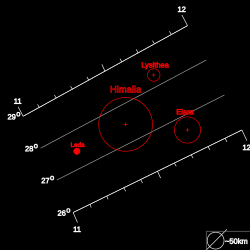Himalia group

The Himalia group is a group of outer moons of Jupiter , which are similar in their orbital properties . Four moons are assigned to the group:
The members of the group are among the irregular moons whose orbits are strongly eccentric and show a clear inclination ( inclination ) compared to the local Laplace plane . The Laplace planes of these moons coincide roughly with the orbital plane of Jupiter at this distance from the planet, but are inclined by up to 1.5 ° to this due to external influences - especially from Saturn. As with all outer moons of Jupiter, the orbital elements of these moons are subject to strong temporal fluctuations.
The orbits of the moons of the Himalia group are prograd ( right-handed ): The moons orbit the planet in the same direction as its direction of rotation . The group members have distances from the central planet between 11 and 12 million km, which corresponds to about 22% of the Hill radius (stable orbits are possible for prograde moons up to a maximum of 47% of the Hill radius).
Jupiter's outer moons with these properties have been given names that end in a since 1976 , whereas the names of retrograde ( retrograde ) irregular moons of Jupiter end with an e ( regular moons are always prograde ).
The Himalia group is named after its largest representative, who is also the fifth largest of all Jupiter's moons. The group may have originated from a single asteroid that was captured by Jupiter's gravity and broke into pieces as a result of tidal forces .
